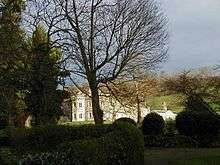Hackness
| Hackness | |
 Hackness |
|
| Population | 221 (Including Broxa-cum-Troutsdale and Darncombe-cum-Langdale Edge. 2011 census)[1] |
|---|---|
| OS grid reference | SE969906 |
| Civil parish | Hackness |
| District | Scarborough |
| Shire county | North Yorkshire |
| Region | Yorkshire and the Humber |
| Country | England |
| Sovereign state | United Kingdom |
| Post town | SCARBOROUGH |
| Postcode district | YO13 |
| Police | North Yorkshire |
| Fire | North Yorkshire |
| Ambulance | Yorkshire |
| EU Parliament | Yorkshire and the Humber |
| UK Parliament | Scarborough and Whitby |
Coordinates: 54°18′06″N 0°30′40″W / 54.301800°N 0.511100°W
Hackness is a village and civil parish in the Scarborough district of the county of North Yorkshire, England, located within the North York Moors National Park.
Hackness is mentioned as the site of a double monastery or nunnery by Bede, writing in the early 8th century. The church of Saint Peter, a Grade I listed building parts of which date from the 11th century,[2] has fragments of a high cross dating from the late 8th or early 9th century.

The fragments preserve parts of a Latin prayer for Saint Æthelburh and an illegible inscription apparently in the runic alphabet.[3]
Hackness Hall and its landscape gardens were created in the 1790s. The house, a Grade I listed building, was commissioned by Sir Richard Van den Bempde-Johnstone, who had inherited the estate through his mother. A new entrance was added in 1810. Fire damage in 1910 was restored under the direction of Walter Brierley.[4]
According to the 2011 UK census, Hackness parish had a population of 221,[1] an increase on the 2001 UK census figure of 125.[5]
The parish council is Hackness & Harwood Dale Group Parish Council which covers the six parishes of Broxa-cum-Troutsdale, Darncombe-cum-Langdale End, Hackness, Harwood Dale, Silpho and Suffield-cum-Everley.[6]
There is a tennis club in the village with three grass courts and two tarmac courts, situated on the road to Lowdales and Highdales. The Club recently celebrated 90 years of tennis in Hackness in 2013. [7]
Notable people
- Margaret, Lady Hoby (1571–1633), who kept the earliest known female diary in English (1599–1605)[8]
- Sir Thomas Posthumous Hoby (1566–1640), lord of the manor and a possible inspiration for Shakespeare's Malvolio in Twelfth Night.[9]
- Matthew Noble (1818–1876), sculptor, did the bust of William Smith (geologist), who was employed at Hackness Hall.[10]
References
- 1 2 "Key Figures for 2011 Census: Key Statistics: Area: Hackness CP (Parish)". Neighbourhood Statistics. Office for National Statistics. Retrieved 7 February 2013.
- ↑ "Church of St Peter, Hackness". British Listed Buildings. Retrieved 3 September 2012.
- ↑ Blair, John (2005). The Church in Anglo-Saxon Society. Oxford University Press. pp. 145–147. ISBN 978-0-19-921117-3.
- ↑ "Hackness Hall and Railings and Railings Attached to Terrace on Garden Front, Hackness". British Listed Buildings. Retrieved 3 September 2012.
- ↑ "2001 Census: Key Statistics: Parish Headcounts: Area: Hackness CP (Parish)". Neighbourhood Statistics. Office for National Statistics. Retrieved 7 July 2008.
- ↑ "Hackness & Harwood Dale Group Parish Council". Hackness & Harwood Dale Group Parish Council. Retrieved 5 July 2008.
- ↑ "Hackness Tennis Club". Lawn Tennis Association. Retrieved 3 September 2012.
- ↑ Hoby [née Dakins], Margaret, 1571-1633. In: The Cambridge Guide to Women's Writing in English (1993). Retrieved 3 September 2012.
- ↑ J. L. Simmons, 'A Source for Shakespeare's Malvolio: The Elizabethan Controversy with the Puritans' in Huntington Library Quarterly, vol. 36 (May 1973), pp. 181–201
- ↑ Geological Society site
External links
| Wikimedia Commons has media related to Hackness. |